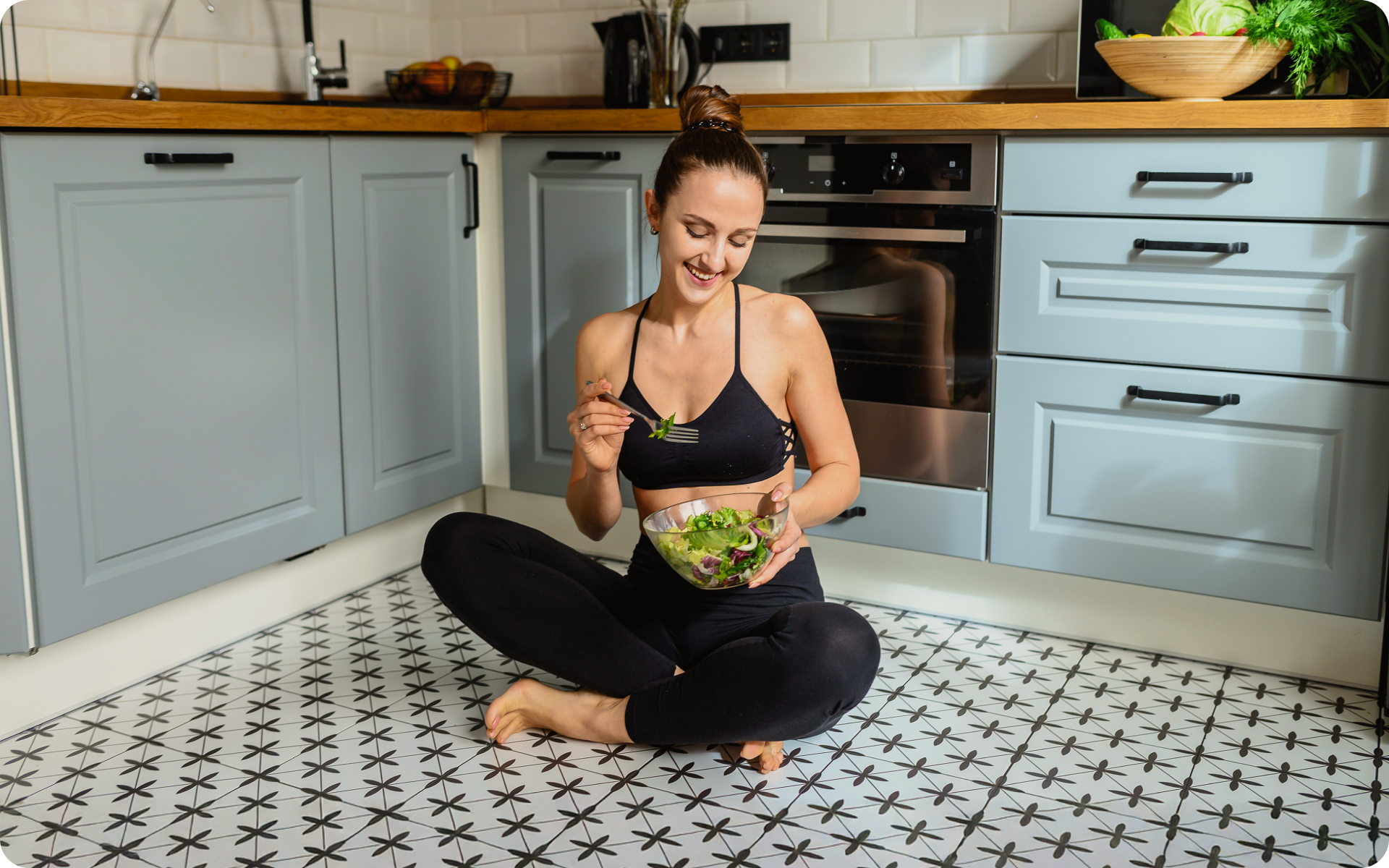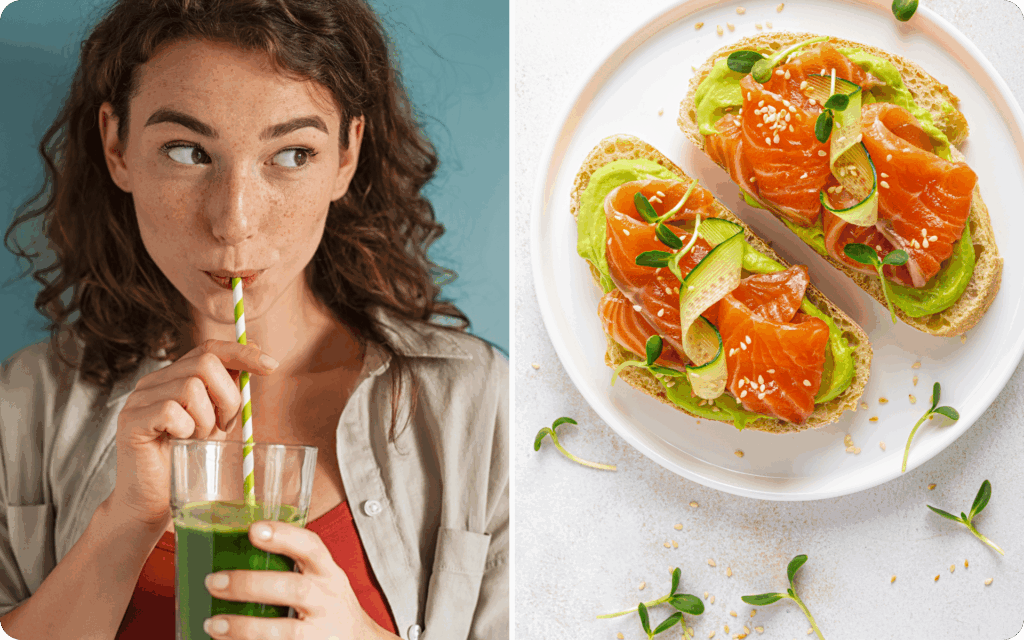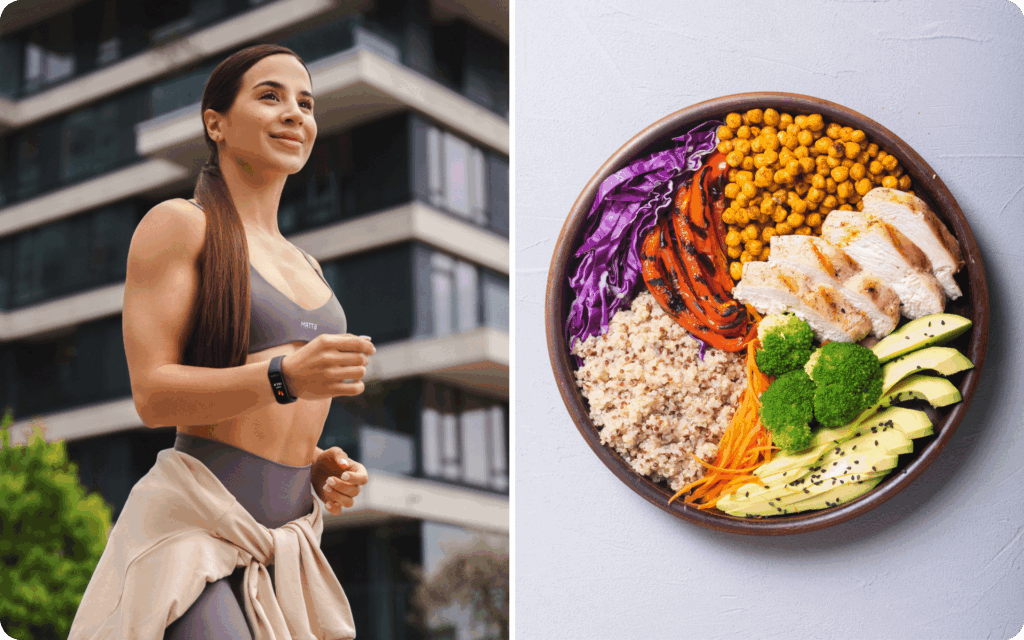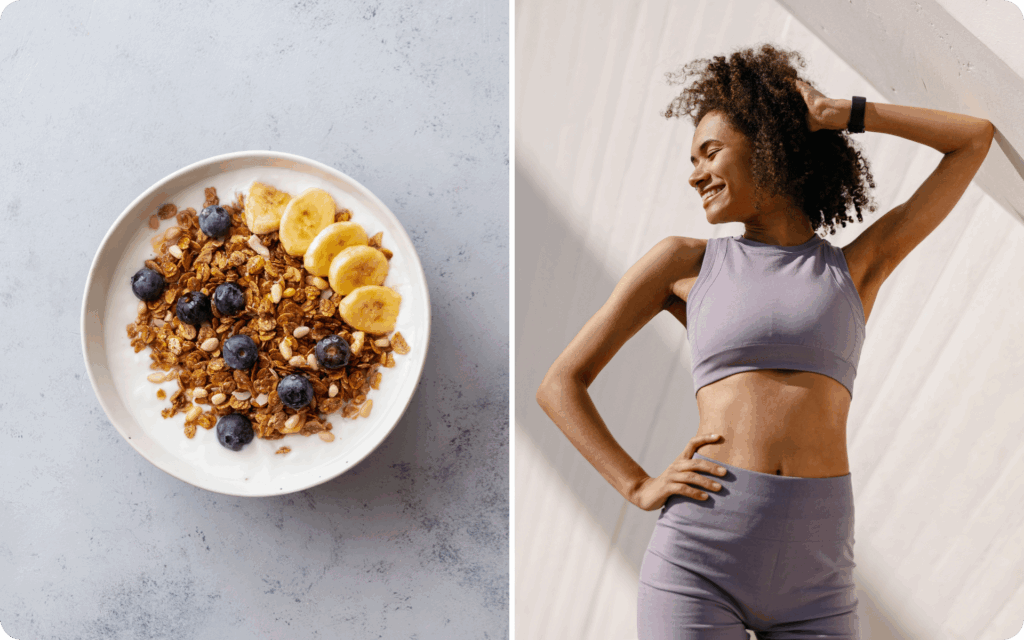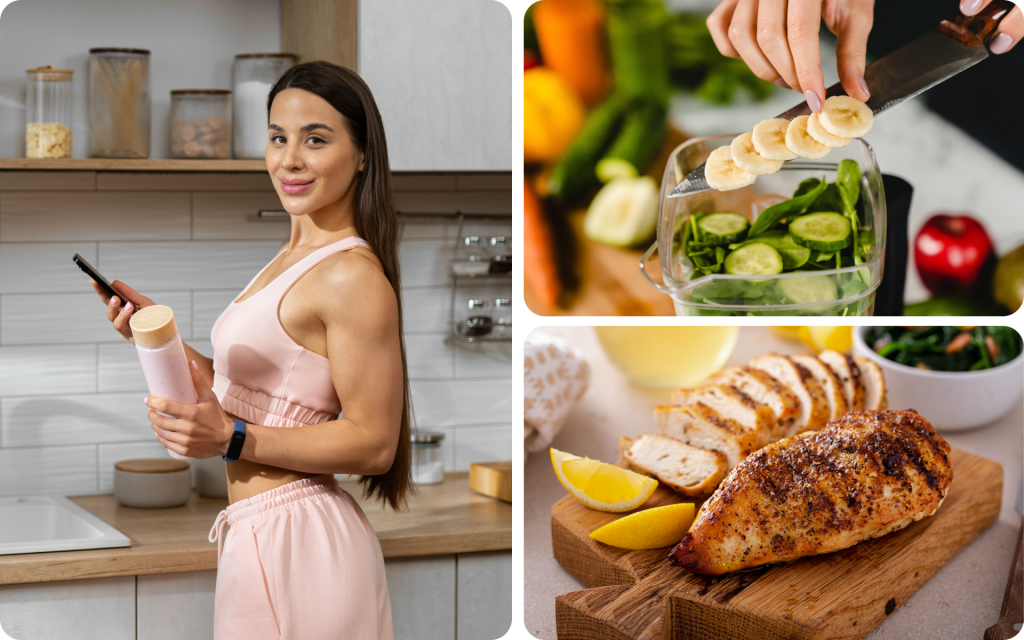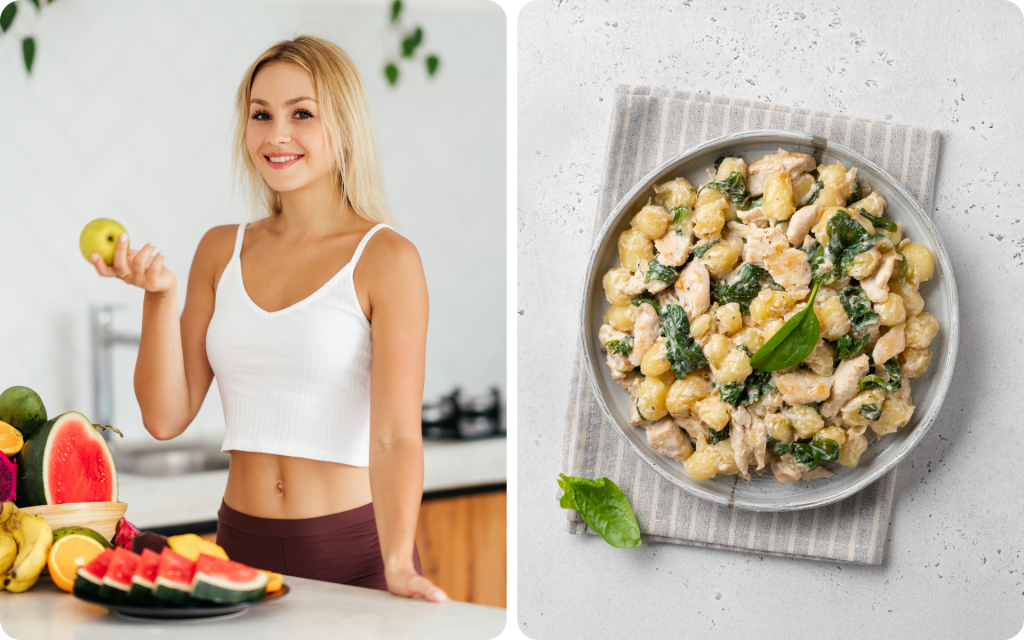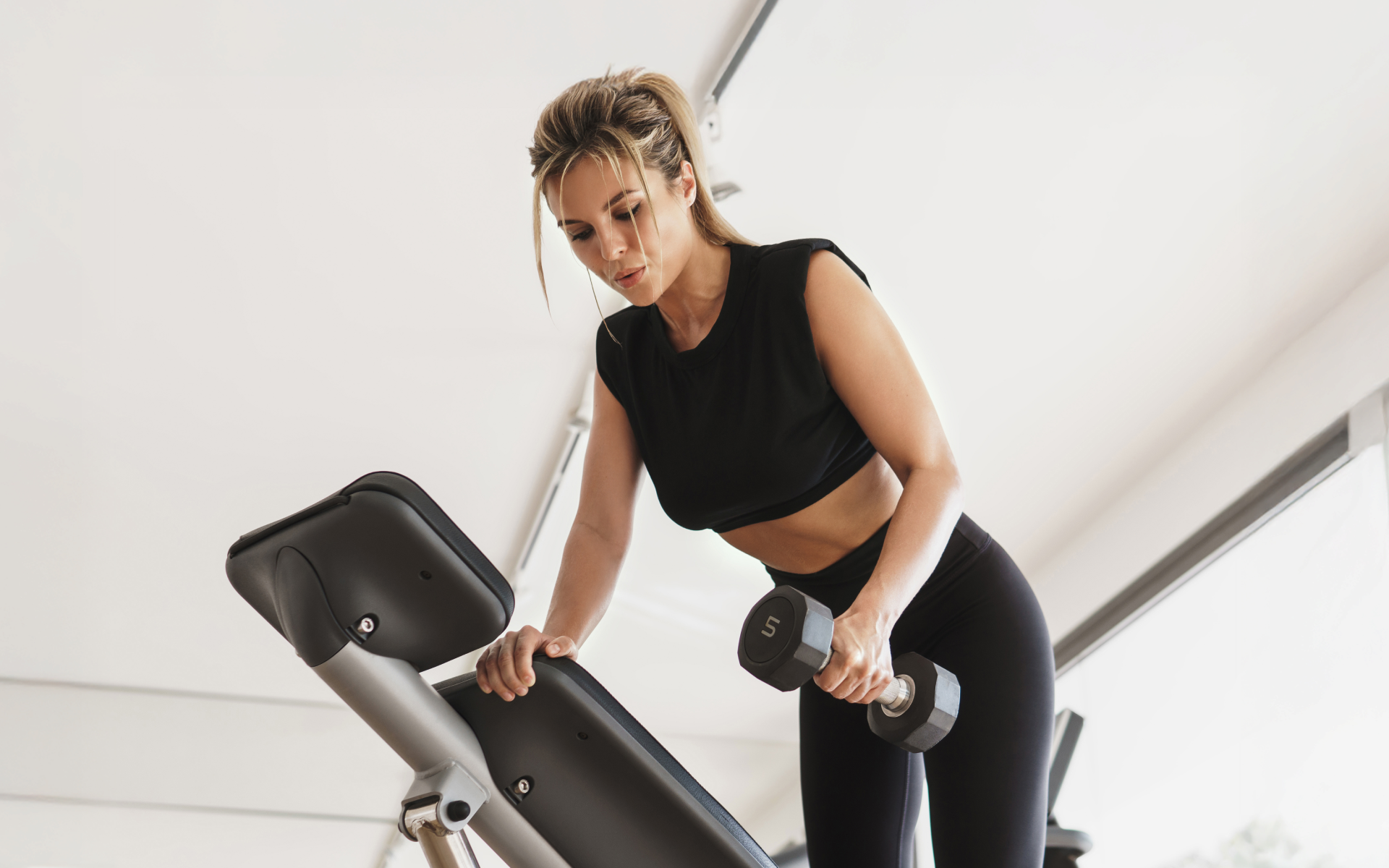Mechanical tension refers to the force exerted on muscles during resistance training, while metabolic stress is the accumulation of byproducts, such as lactate, that occurs during exercise.
These two factors primarily drive muscle growth by signaling the body to adapt, resulting in increased muscle size and strength (1).
However, nutrition is equally important in creating an internal environment conducive to hypertrophy.
The proper nutrition for gaining muscle involves:
- Consuming adequate protein provides the amino acids necessary for muscle protein synthesis.
- Maintaining a slight calorie surplus to fuel growth (2).
- Ensuring proper recovery to allow the body to adapt to training stimuli (3).
While protein often takes center stage in discussions about muscle gain, carbohydrates and fats are equally important for providing energy, supporting hormonal health, and optimizing performance (4, 5).
In this article, we’ll share a 7-day meal plan tailored to support muscle gain.
This plan emphasizes high-quality protein sources, balanced macronutrients, and nutrient-dense foods to help you achieve your health and wellness goals.
What Foods Should A 7-Day Meal Plan For Lean Muscle Gain Include?
Eating nutrient-dense, balanced meals provides the essential fuel your body needs to perform, repair, recover, and grow.
- Protein Sources
Protein is the foundation of muscle growth.
It supplies the amino acids necessary for muscle protein synthesis, which is the process where your body repairs and builds muscle tissue after exercise (6).
Aim for a variety of high-quality protein sources to meet your needs:
- Lean meats for weight loss and muscle gain: Chicken breast, turkey, lean beef.
- Fish: Salmon, tuna, cod.
- Eggs: Both whole eggs and egg whites.
- Dairy: Greek yogurt, cottage cheese, low-fat milk.
- Plant-based options: Tofu, tempeh, lentils, and quinoa.
- Protein supplements (optional, not essential): Whey protein, plant-based protein powders.
- Carbohydrates
Carbs are your body’s primary source of energy. They fuel your workouts, replenish glycogen stores, and help sustain your performance (4).
A mix of complex and simple carbohydrates ensures steady energy and recovery.
- Whole grains: Brown rice, quinoa, oats, whole wheat bread.
- Starchy vegetables: Sweet potatoes, white potatoes, and squash.
- Legumes: Black beans, chickpeas.
- Fruits: Bananas, berries, oranges, apples.
- Pasta (whole grain for added fiber).
When it comes to weight loss, progress is made by inches, not miles, so it’s much harder to track and a lot easier to give up. The BetterMe: Health Coaching app is your personal trainer, nutritionist, and support system all in one. Start using our app to stay on track and hold yourself accountable!
- Healthy Fats
Healthy fats play a crucial role in hormone production, including testosterone, which is vital for muscle growth (7).
They also offer a dense source of calories to help maintain a slight surplus for muscle gain without overeating:
- Nuts and seeds: Almonds, walnuts, chia seeds, flaxseeds.
- Avocado.
- Oils: Olive oil, canola oil, and other vegetable oils.
- Fatty fish: Salmon, mackerel, sardines.
- Nut butters (natural, no added sugar).
- Vegetables
Vegetables contain high amounts of vitamins, minerals, and antioxidants that support overall health and aid recovery (8).
They’re also a great source of fiber to help with digestion, especially when increasing protein intake (9).
- Leafy greens: Spinach, kale, arugula, cabbage.
- Cruciferous vegetables: Broccoli, cauliflower, Brussels sprouts.
- Colorful options: Bell peppers, carrots, zucchini.
- Fiber-rich choices: Green beans, asparagus, and artichokes.
- Snacks
Snacks offer an opportunity to pack in extra nutrients and calories without feeling weighed down.
They can bridge the gap between meals, keeping your energy stable throughout the day (10).
- High-protein options: Hard-boiled eggs, beef jerky, protein bars (check for minimal added sugar).
- Fruits and nuts.
- Greek yogurt with berries.
- Rice cakes with almond butter.
- Trail mix (opt for mixes with natural ingredients).
The above are only a sampling of options from each food group. Feel free to include the foods you like, are accessible to you, and within your budget for a cheap 7-day meal plan for muscle gain.
- Shop seasonally
- Take advantage of sales.
- Leverage frozen ingredients and canned goods to maintain variety without overspending.
Read more: Hitting 25 Grams of Fiber: Daily Guide, High-Fiber Foods, and Smart Snacking
How Many Meals Per Day Optimize Lean Muscle Growth?
There’s no set number of meals you should eat per day to optimize lean muscle growth.
Meeting your total energy needs for the day is more critical than how many meals you spread them across. For lean muscle growth, many people may benefit from a slight calorie surplus to provide the energy their body needs for muscle repair and growth.
However, a surplus isn’t always a necessity for building muscle:
- Slight Calorie Surplus: For individuals aiming to maximize muscle gain, consuming more calories than you burn (approximately 10-15% above maintenance) can help (11).
- Calorie Maintenance: To gain muscle without gaining fat, aim for a calorie intake that helps you maintain your weight. With the right resistance training program, muscle growth is still possible.
- Recomposition Goals (gaining muscle while losing fat): You can achieve body recomposition without a surplus, provided your protein intake is high and exercise is consistent.
You might have heard that eating more often “stokes your metabolism” or leads to greater muscle gains. Current research, however, indicates that meal frequency itself isn’t the primary factor in determining muscle growth.
Instead, it’s about meeting your daily nutritional needs and perhaps spreading protein throughout the day to support muscle protein synthesis (12).
Most people will do well with 3-6 meals or snacks daily. The frequency you choose can depend on your preferences, lifestyle, appetite, and schedule.
- 3 Meals A Day: Ideal for those with busy routines or who prefer larger, more filling meals. Each one should include a high-quality protein source to maximize muscle-building opportunities.
- 4–6 Smaller Meals or Snacks: Ideal for individuals who feel best eating smaller portions more frequently, or who want to manage hunger and maintain steady energy for workouts.
Regardless of how many meals you eat, aim to include a source of protein at every eating occasion. Spacing protein intake throughout the day (every 3–5 hours) helps maintain a positive net protein balance, which is helpful for muscle repair and growth.
What’s The Ideal Protein Intake For A 7-Day Muscle Gain Plan?
The current consensus from sports nutrition research suggests aiming for 1.2-2 grams of protein per kilogram of body weight per day to support muscular growth during resistance training.
For most active adults, this range ensures your body has the amino acids it needs for muscle protein synthesis, the process of building and repairing muscle tissue (13).
To put this into perspective:
- A person weighing 70 kg (about 154 lbs) would need approximately 84–140 grams of protein each day.
- Someone who weighs 85 kg (about 187 lbs) should aim for 102–170 grams per day.
Dividing your total daily protein into 3–6 evenly spaced meals or snacks—rather than loading up at a single meal—may further enhance muscle protein synthesis (12).
As a practical guide, try to include a quality protein source at each main meal, such as:
- Breakfast: Eggs or Greek yogurt
- Lunch: Chicken breast, tuna, or lentils
- Dinner: Salmon, lean beef, or tofu
- Snacks: Cottage cheese, protein smoothies, or hard-boiled eggs
If you’re new to tracking, reading labels, and planning meals, this method can help ensure you’re hitting your target range. And remember that variety matters.
Different protein-rich foods provide other nutrients your body needs for recovery, energy, and overall well-being.
How To Balance Carbs And Fats For Lean Gains?
A common starting point for macronutrient distribution in a muscle gain plan is (14):
- 45-55% of calories from carbohydrates
- 20-35% of calories from fats
- 25-35% of calories from protein
We can adjust these ratios based on individual preferences, activity levels, and metabolic needs. For example, endurance athletes or those with high training volumes may benefit from a higher carbohydrate intake.
At the same time, individuals with lower activity levels may lean toward a lower-carbohydrate, higher-fat approach.
- On training days, prioritize carbohydrates to fuel your workouts and support recovery.
- On rest days, slightly increase fats to maintain energy balance.
Sample 7-Day Meal Plan For Muscle Gain
So, what are quick meal prep ideas for a 7-day muscle plan?
You’re in the right place because this meal plan provides a balanced mix of macronutrients, high-quality protein, and nutrient-dense foods, adhering to the recommended guidelines of 45-55% carbs, 25-35% protein, and 20-35% fat.
Consider portion sizes and adjust amounts to fit your unique calorie needs for a lean muscle diet with easy meal prep.
Day 1
- Breakfast: Scrambled eggs (2 whole, 2 whites), whole grain toast, avocado slices, fresh berries
- Snack: Greek yogurt (plain, high-protein) with walnuts and mixed fruit
- Lunch: Grilled chicken breast, brown rice, roasted broccoli and carrots, olive oil drizzle
- Snack: Rice cakes with natural almond butter and banana slices
- Dinner: Baked salmon, quinoa, sautéed spinach, side salad with vinaigrette
Day 2
- Breakfast: Protein smoothie (whey or plant-based protein, frozen berries, spinach, oats, almond milk)
- Snack: Hard-boiled eggs and apple slices
- Lunch: Turkey and hummus wrap on whole wheat tortilla, snap peas, and cherry tomatoes
- Snack: Edamame and a handful of almonds
- Dinner: Lean beef stir-fry with bell peppers, brown rice, and sesame oil
Day 3
- Breakfast: Overnight oats with chia seeds, protein powder, diced apple, and almond butter
- Snack: Cottage cheese with pineapple
- Lunch: Grilled shrimp tacos on corn tortillas, cabbage slaw, avocado
- Snack: Protein bar (low sugar) and blueberries
- Dinner: Herb-roasted chicken thighs, baked sweet potato, green beans
Day 4
- Breakfast: Omelet with mushrooms, spinach, and feta cheese, whole grain English muffin
- Snack: Trail mix (nuts, seeds, dried cranberries)
- Lunch: Tuna salad sandwich (on whole grain bread), mixed leaf salad, olive oil vinaigrette
- Snack: Sliced cucumbers with hummus
- Dinner: Baked cod fillet, wild rice, steamed asparagus
Day 5
- Breakfast: Pancakes made with oats and cottage cheese, topped with fresh strawberries and a dollop of Greek yogurt
- Snack: Sliced pear and string cheese
- Lunch: Grilled turkey burger, quinoa salad with chickpeas, tomatoes, and parsley
- Snack: Carrot sticks and guacamole
- Dinner: Lean pork tenderloin, mashed potatoes, roasted Brussels sprouts
Day 6
- Breakfast: Smoothie bowl (banana, protein powder, mixed berries, spinach), topped with pumpkin seeds
- Snack: Rice cakes with natural peanut butter
- Lunch: Chicken and veggie stir-fry (broccoli, snap peas, carrots) over brown rice
- Snack: Low-fat cottage cheese with peach slices
- Dinner: Baked tofu, roasted sweet potato, spinach salad with sunflower seeds
If you wish to free yourself from all the extra pounds that have been weighing you down for way too long, start using the BetterMe: Health Coaching app and overhaul your entire life!
Day 7
- Breakfast: Scrambled eggs, whole wheat toast, sliced tomatoes, and sautéed mushrooms
- Snack: Greek yogurt and granola
- Lunch: Salmon and avocado sushi rolls, edamame
- Snack: Protein shake and mixed fruit
- Dinner: Baked chicken breast, farro, roasted zucchini, and red peppers
Rotate snacks and main meals as needed for variety and to suit your tastes.
Always ensure your plate features a source of lean protein, a complex carbohydrate, colorful veggies, and a healthy fat with each meal.
Read more: Bulking Meal Prep Plan: Tips for a Healthy and Effective Plan
How To Stay Full On A Lean Muscle Gain Diet?
Implementing these strategies can help you feel full on your 7-day meal plan for lean muscle gain female or 7-day meal plan for muscle gain male.
Maintaining your satisfaction makes it easier to stick to your nutrition plan and focus on your training goals:
- Prioritize Protein At Every Meal
Including a high-quality protein source with every meal and snack helps support muscle growth and keeps you feeling full for a longer period. Protein slows digestion and may reduce the spike and dip in blood sugar that can trigger hunger (6).
- Load Up On Fibre-Rich Foods
Whole grains, legumes, fruits, and vegetables add bulk to meals and slow digestion. Fibre-rich choices, such as lentils, oats, berries, and leafy greens, not only promote satiety but also help stabilize appetite throughout the day (9).
- Choose Volume Foods
Add generous portions of lower-calorie, non-starchy vegetables, like cucumbers, tomatoes, and leafy greens. These can increase meal volume, helping your stomach feel fuller for longer without a lot of extra calories (8).
- Opt For Balanced Fats
Incorporate healthy fats, such as avocado, olive oil, chia seeds, or a handful of nuts, into your diet.
Fats contribute to longer-lasting fullness and enhance meal satisfaction (15).
- Eat Mindfully And Slow Down
Take time with your meals by putting down your fork between bites and paying attention to hunger and fullness cues. Mindful eating allows your body time to register satisfaction and can help reduce mindless snacking or “food noise (16).”
- Stay Hydrated
Sometimes, thirst can masquerade as hunger. Drink water throughout the day and consider a glass before or with meals to help with both hydration and satiety (17).
- Plan Consistent Meal and Snack Times
Establish a regular meal schedule to prevent becoming overly hungry or preoccupied with food. Consistency helps regulate appetite hormones and can reduce intrusive food thoughts (10).
- Include Complex Carbohydrates
Favour slower-digesting carbs like brown rice, sweet potatoes, and quinoa.
These help provide steady energy and a more lasting feeling of fullness than refined grains (4).
- Manage Stress and Sleep
High stress and poor sleep can ramp up cravings and disrupt appetite regulation (18).
Aim to incorporate restful sleep and stress-management practices, such as deep breathing, movement, or meditation, to support balanced hunger levels.
Muscle growth, or hypertrophy, typically takes weeks to months of consistent training and proper nutrition. However, within a week, you may experience initial changes, such as improved muscle activation and glycogen storage, which can make muscles appear fuller. Signs include lack of energy, poor workout performance, no changes in muscle size or strength, and feeling excessively hungry or overly full. Adjust calorie intake, macronutrient balance, or meal timing as needed. Yes, slightly. On workout days, prioritize carbohydrates to fuel performance and recovery. On rest days, you can reduce carbs slightly and increase healthy fats if it helps to maintain energy balance. If you’re curious about a lean calisthenics body, check out our earlier article. Absolutely. Focus on plant-based protein sources, such as tofu, tempeh, lentils, quinoa, and beans. Pair these with whole grains, nuts, seeds, and dairy or plant-based protein powders to meet protein needs.Frequently Asked Questions
Do muscles grow in a week?
What are signs the meal plan isn’t working?
Should the meal plan change on workout vs. rest days?
Can vegetarians follow a 7-day lean muscle meal plan?
The Bottom Line
Gaining lean muscle requires a combination of consistent exercise and a balanced diet.
A nutrient-rich meal plan that includes adequate protein, complex carbs, healthy fats, and micronutrients is essential for building muscle mass. By following a 7-day lean muscle meal plan and making wise food choices throughout the week, you can support your body’s muscle-building efforts and reach your fitness goals.
DISCLAIMER:
This article is intended for general informational purposes only and does not serve to address individual circumstances. It is not a substitute for professional advice or help and should not be relied on for making any kind of decision-making. Any action taken as a direct or indirect result of the information in this article is entirely at your own risk and is your sole responsibility.
BetterMe, its content staff, and its medical advisors accept no responsibility for inaccuracies, errors, misstatements, inconsistencies, or omissions and specifically disclaim any liability, loss or risk, personal, professional or otherwise, which may be incurred as a consequence, directly or indirectly, of the use and/or application of any content.
You should always seek the advice of your physician or other qualified health provider with any questions you may have regarding a medical condition or your specific situation. Never disregard professional medical advice or delay seeking it because of BetterMe content. If you suspect or think you may have a medical emergency, call your doctor.
SOURCES:
- Maximizing Muscle Hypertrophy: A Systematic Review of Advanced Resistance Training Techniques and Methods (2019, mdpi.com)
- Editorial: Nutritional Strategies to Promote Muscle Mass and Function Across the Health Span (2020, frontiersin.org)
- The Importance of Recovery in Resistance Training Microcycle Construction (2024, pmc.ncbi.nlm.nih.gov)
- High-Quality Carbohydrates and Physical Performance (2018, journals.lww.com)
- Effects of dietary fat on muscle substrates, metabolism, and performance in athletes (2003, pubmed.ncbi.nlm.nih.gov)
- Systematic review and meta-analysis of protein intake to support muscle mass and function in healthy adults (2022, onlinelibrary.wiley.com)
- Manipulation of Dietary Intake on Changes in Circulating Testosterone Concentrations (2021, mdpi.com)
- Health Benefits of Vegetables (2024, webmd.com)
- Therapeutic Benefits and Dietary Restrictions of Fiber Intake: A State of the Art Review (2022, mdpi.com)
- The Science of Snacking (2021, nutritionsource.hsph.harvard.edu)
- Is an Energy Surplus Required to Maximize Skeletal Muscle Hypertrophy Associated With Resistance Training (2019, pmc.ncbi.nlm.nih.gov)
- Protein Distribution and Muscle-Related Outcomes: Does the Evidence Support the Concept? (2020, mdpi.com)
- Protein intake for athletes and active adults: Current concepts and controversies (2016, onlinelibrary.wiley.com)
- Macronutrient Considerations for the Sport of Bodybuilding (2004, utoledo.edu)
- A healthy approach to dietary fats: understanding the science and taking action to reduce consumer confusion (2017, nutritionj.biomedcentral.com)
- Mindful Eating: The Art of Presence While You Eat (2017, pmc.ncbi.nlm.nih.gov)
- Health Promotion and Hydration: A Systematic Review About Hydration Care (2022, pmc.ncbi.nlm.nih.gov)
- The effects of sleep disruption on metabolism, hunger, and satiety, and the influence of psychosocial stress and exercise: A narrative review (2023, onlinelibrary.wiley.com)
